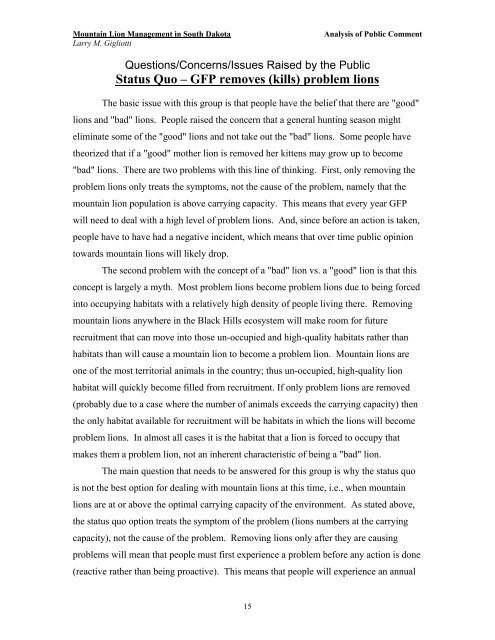South Dakota Mountain Lion Public Opinion Poll
South Dakota Mountain Lion Public Opinion Poll
South Dakota Mountain Lion Public Opinion Poll
Create successful ePaper yourself
Turn your PDF publications into a flip-book with our unique Google optimized e-Paper software.
<strong>Mountain</strong> <strong>Lion</strong> Management in <strong>South</strong> <strong>Dakota</strong> Analysis of <strong>Public</strong> Comment<br />
Larry M. Gigliotti<br />
Questions/Concerns/Issues Raised by the <strong>Public</strong><br />
Status Quo – GFP removes (kills) problem lions<br />
The basic issue with this group is that people have the belief that there are "good"<br />
lions and "bad" lions. People raised the concern that a general hunting season might<br />
eliminate some of the "good" lions and not take out the "bad" lions. Some people have<br />
theorized that if a "good" mother lion is removed her kittens may grow up to become<br />
"bad" lions. There are two problems with this line of thinking. First, only removing the<br />
problem lions only treats the symptoms, not the cause of the problem, namely that the<br />
mountain lion population is above carrying capacity. This means that every year GFP<br />
will need to deal with a high level of problem lions. And, since before an action is taken,<br />
people have to have had a negative incident, which means that over time public opinion<br />
towards mountain lions will likely drop.<br />
The second problem with the concept of a "bad" lion vs. a "good" lion is that this<br />
concept is largely a myth. Most problem lions become problem lions due to being forced<br />
into occupying habitats with a relatively high density of people living there. Removing<br />
mountain lions anywhere in the Black Hills ecosystem will make room for future<br />
recruitment that can move into those un-occupied and high-quality habitats rather than<br />
habitats than will cause a mountain lion to become a problem lion. <strong>Mountain</strong> lions are<br />
one of the most territorial animals in the country; thus un-occupied, high-quality lion<br />
habitat will quickly become filled from recruitment. If only problem lions are removed<br />
(probably due to a case where the number of animals exceeds the carrying capacity) then<br />
the only habitat available for recruitment will be habitats in which the lions will become<br />
problem lions. In almost all cases it is the habitat that a lion is forced to occupy that<br />
makes them a problem lion, not an inherent characteristic of being a "bad" lion.<br />
The main question that needs to be answered for this group is why the status quo<br />
is not the best option for dealing with mountain lions at this time, i.e., when mountain<br />
lions are at or above the optimal carrying capacity of the environment. As stated above,<br />
the status quo option treats the symptom of the problem (lions numbers at the carrying<br />
capacity), not the cause of the problem. Removing lions only after they are causing<br />
problems will mean that people must first experience a problem before any action is done<br />
(reactive rather than being proactive). This means that people will experience an annual<br />
15
















